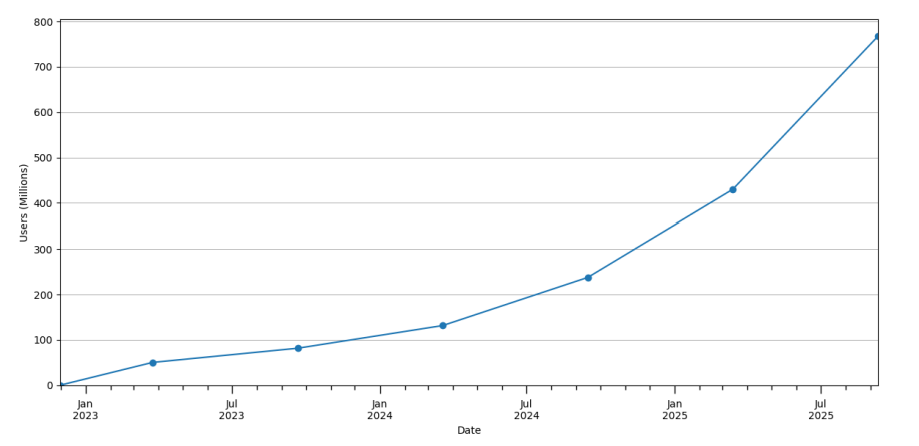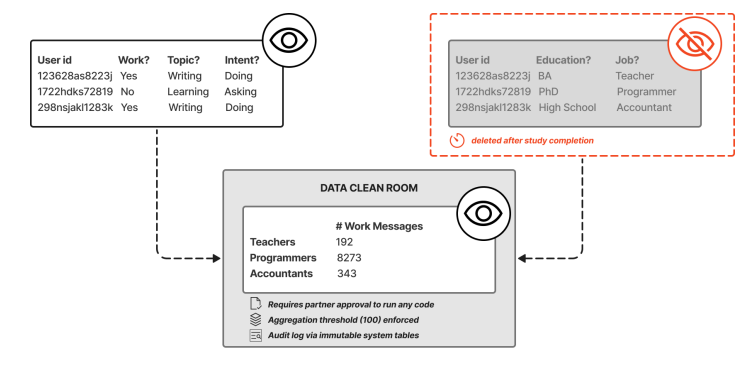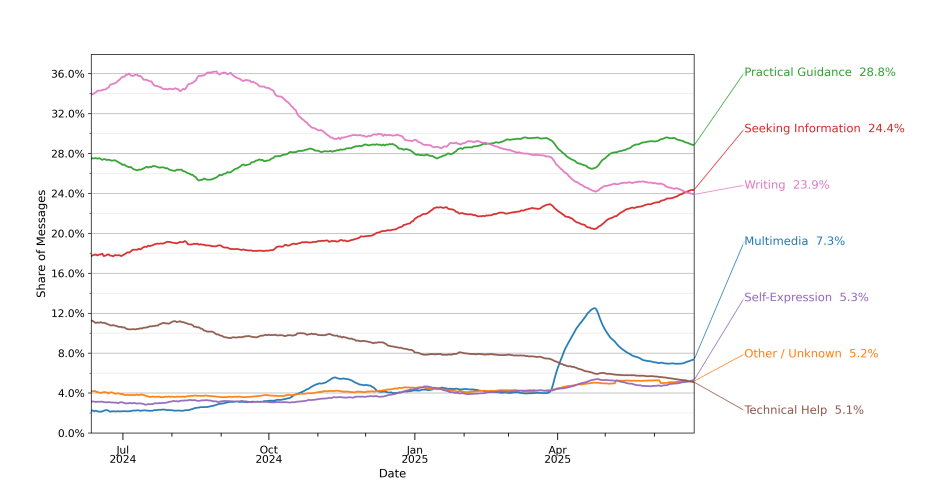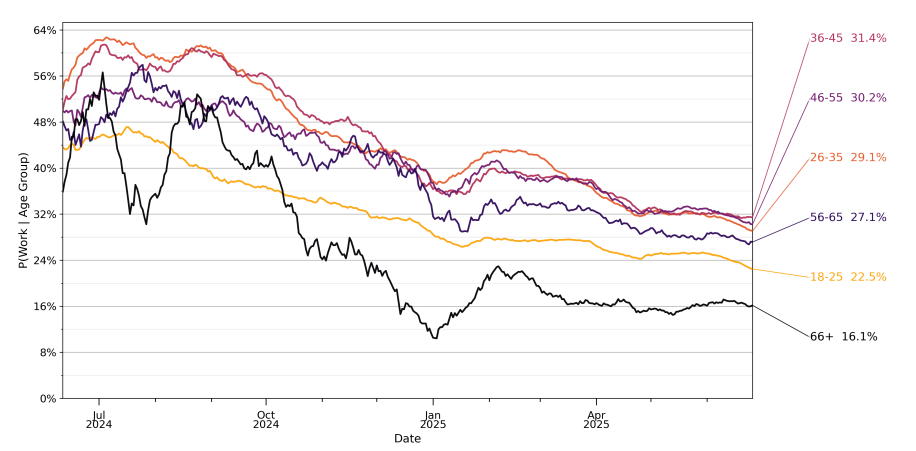Understanding the ChatGPT Revolution
- Juan Manuel Ortiz de Zarate

- Sep 18
- 11 min read
The rapid global adoption of Large Language Model (LLM) chatbots, particularly ChatGPT, has marked an unprecedented technological diffusion. Despite this widespread embrace, detailed insights into how consumers actually utilize these powerful AI tools have remained limited. This article synthesizes findings from a comprehensive NBER working paper [1] that leverages a unique, privacy-preserving methodology to analyze billions of ChatGPT messages from its launch in November 2022 through July 2025. The study reveals critical trends in usage patterns, distinguishing between work and non-work applications, identifying dominant conversation topics and user intents, mapping interactions to occupational activities, and detailing demographic variations. Key findings indicate a significant shift towards non-work-related usage, the prominence of practical guidance and writing tasks, and a narrowing gender gap in adoption. Ultimately, the research underscores ChatGPT’s substantial economic value through decision support, especially in knowledge-intensive roles, and highlights its broad-based impact on the global economy.

Introduction
The advent of Large Language Models (LLMs) and their integration into user-friendly chatbots like ChatGPT represents a significant acceleration in Artificial Intelligence capabilities over the past decade. Launched in November 2022, ChatGPT swiftly became the first mass-market chatbot, achieving an unparalleled speed [2] of global diffusion. By July 2025, it had amassed over 700 million weekly active users, representing approximately 10% of the world’s adult population, with 18 billion messages sent each week. This rapid adoption has ignited intense interest in AI's potential effects on economic growth[5], employment[4], and society[6] at large. However, despite this dramatic growth, concrete public information regarding the actual mechanisms and patterns of LLM usage has been scarce. While surveys have measured self-reported adoption, these methods can be prone to bias, and none have directly tracked the quantity or nature of chatbot conversations.
This article delves into the comprehensive analysis provided by a seminal NBER working paper that addresses this crucial knowledge gap. The study distinguishes itself from prior research by utilizing a significantly larger pool of users, employing automated classifiers with novel taxonomies for message classification, documenting usage diffusion and growth within user cohorts, and analyzing aggregated employment and education categories with rigorous privacy protocols, building on previous work investigating fairness in chatbots. By doing so, it offers profound insights into how people truly interact with ChatGPT, shedding light on its real-world impact and value.
Methodology: Unveiling Usage Patterns with Privacy at its Core
The study's robust methodology is central to its groundbreaking findings, emphasizing user privacy throughout the analysis. Researchers implemented a secure data clean room protocol and an automated classification pipeline, ensuring that no human ever accessed the content of user messages. This approach allowed for the analysis of vast datasets while adhering strictly to OpenAI’s Privacy Policy.
The analysis was based on several key datasets:
Growth Dataset: This compiled total daily message volumes from consumer ChatGPT plans (Free, Plus, Pro) from November 2022 to September 2025. It included de-identified user metadata such as the timestamp of their first interaction, country of registration, subscription plan, and self-reported age (in coarse buckets for privacy).
Classified Messages: This comprised random samples of de-identified messages from logged-in consumer users between May 2024 and July 2025. Messages were classified using five different LLM-based classifiers according to various taxonomies: work-relatedness, conversation topic, user intent (Asking, Doing, Expressing), and the O*NET task being performed. The classification process involved LLMs acting on message content, augmented with context from up to 10 preceding messages, to discern user intent. Messages were truncated to 5,000 characters to maintain classification quality.
Employment Dataset: For a subset of users, aggregated employment and education categories were procured from publicly available sources via a secure Data Clean Room (DCR). This DCR environment enforced strict aggregation limits (a minimum of 100 users per category) to prevent access to individual-level demographic records.

The automated classifiers were rigorously validated against human-judged classifications using the publicly available WildChat dataset[3]. This validation ensured high agreement rates between the model and human plurality labels for categories like work-relatedness and user intent, bolstering confidence in the classification accuracy.
The Unprecedented Growth of ChatGPT
ChatGPT’s diffusion has been nothing short of extraordinary. Launched as a "research preview" in November 2022, it registered over one million users within five days. By the end of July 2025, the platform had grown to over 700 million weekly active users on its consumer plans. This figure represents an astounding 10% of the world's adult population, a speed of global technological diffusion that is unprecedented.

The growth in message volume mirrors this user adoption. Between July 2024 and July 2025, the daily message volume from consumer plans increased by more than five times. This growth wasn't solely driven by new users; existing cohorts also exhibited continuous increases in usage. For instance, messages from the earliest cohort of ChatGPT users (those who signed up by Q1 2023) declined slightly in 2023 but rebounded strongly in late 2024, reaching their highest-ever levels by 2025. This consistent growth within every cohort is attributed to both improvements in model capabilities and users gradually discovering new applications for the existing features. Earlier sign-ups consistently showed higher usage per weekly active user, indicating a deepening engagement over time.
Diving Deep into Usage Patterns
Work vs. Non-Work Dynamics
One of the most striking findings of the study is the evolving dynamic between work-related and non-work-related usage of ChatGPT. While both categories experienced continuous growth, non-work messages surged at a significantly faster rate. In June 2024, non-work messages accounted for 53% of all consumer ChatGPT messages; by June 2025, this share had climbed to over 70%. This dramatic shift suggests that while AI's impact on paid work productivity has been a primary focus of economic analysis, its influence on activities outside of work, such as "home production," is on a comparable, if not larger, scale. The paper highlights that this decrease in the share of work-related messages is predominantly due to changes in usage patterns within existing user cohorts, rather than a shift in the composition of new users. This aligns with estimates of substantial consumer surplus derived from generative AI, suggesting significant value creation beyond the workplace.
Dominant Conversation Topics
The research categorized ChatGPT conversations into seven broad topics, with "Practical Guidance," "Seeking Information," and "Writing" collectively dominating usage, accounting for nearly 80% of all interactions.
Practical Guidance emerged as the most common use case, encompassing activities like tutoring, providing "how-to" advice across diverse subjects, and facilitating creative ideation. This category emphasizes customized responses tailored to the user's specific needs, adaptable through conversation.
Seeking Information involves queries for factual data on people, current events, products, or recipes, appearing to be a direct substitute for traditional web search.
Writing includes the generation, editing, critiquing, summarizing, or translating of emails, documents, and other communications. This category is particularly prevalent in work-related tasks, accounting for 40% of such messages in June 2025. Notably, about two-thirds of all writing-related messages involve modifying user-provided text rather than generating new content from scratch.
In contrast to some other studies, the paper found that "Computer Programming" constituted a relatively small share of messages (only 4.2%). Other work has noted higher programming usage, such as findings that 33% of work-related Claude conversations were related to computer programming. Similarly, "Relationships and Personal Reflection" (1.9%) and "Games and Role Play" (0.4%) represented minor portions of overall usage, challenging the notion that companionship or social-emotional issues are primary use cases for generative AI[7]. The study also highlighted education as a key application, with about 10% of all messages dedicated to "Tutoring or Teaching" requests.

User Intent: Asking, Doing, and Expressing
To further understand how users interact with generative AI, the study introduced a taxonomy classifying messages by user intent: "Asking," "Doing," or "Expressing".
Asking messages involve seeking information or clarification to inform decisions, aligning with problem-solving models of knowledge work.
Doing messages are requests for ChatGPT to produce some output or perform a specific task, consistent with classic task-based models of work.
Expressing messages convey views or feelings without seeking information or action.
Overall, approximately 49% of user messages were classified as "Asking," 40% as "Doing," and 11% as "Expressing". However, within work-related contexts, "Doing" messages were more prevalent, comprising nearly 56% of queries, with almost three-quarters of these being writing tasks. Over the past year, "Asking" and "Expressing" messages have grown significantly faster than "Doing" messages. Furthermore, "Asking" messages consistently received higher quality ratings, both from an automated user satisfaction classifier and direct user feedback. This suggests that users derive substantial value from ChatGPT in supporting decision-making rather than solely automating tasks.
Mapping to O*NET Work Activities
The study utilized the Occupational Information Network (O*NET) database to map message content to specific work activities, offering insights into the types of tasks ChatGPT assists with across various professions, a methodology similar to other research on the occupational implications of generative AI. The messages were classified into 332 Intermediate Work Activities (IWAs) and then aggregated into 41 Generalized Work Activities (GWAs).
The analysis revealed that nearly half of all messages (45.2%) were associated with three GWAs related to information use and manipulation: "Getting Information" (19.3%), "Interpreting the Meaning of Information for Others" (13.1%), and "Documenting/Recording Information" (12.8%). For work-related messages, "Documenting/Recording Information" (18.4%), "Making Decisions and Solving Problems" (14.9%), and "Thinking Creatively" (13.0%) were among the most common GWAs. The majority of ChatGPT usage at work concentrates on two broad functions: obtaining, documenting, and interpreting information; and making decisions, giving advice, solving problems, and thinking creatively. Remarkably, the work activities associated with ChatGPT usage are highly similar across diverse occupations, with "Getting Information" and "Making Decisions and Solving Problems" frequently appearing in the top five for nearly all professional categories, from management to STEM to administrative roles.
Interaction Quality and User Satisfaction
The paper also explored user satisfaction through an automated "Interaction Quality" classifier, which gauged expressions of satisfaction or dissatisfaction in subsequent user messages. Between late 2024 and July 2025, "Good" interactions significantly outpaced "Bad" ones, growing to be more than four times as common. This upward trend in positive interactions indicates an improvement in user experience or an increased alignment of ChatGPT's responses with user expectations.
Analysis of quality ratings by conversation topic showed that "Self-Expression" had the highest good-to-bad ratio, while "Multimedia" and "Technical Help" had the lowest. Crucially, "Asking" messages were found to be substantially more likely to receive a good rating compared to "Doing" or "Expressing" messages. This reinforces the idea that ChatGPT's value often lies in its capacity to provide decision support and guidance.

Demographic Insights: Who is Using ChatGPT?
The study provided critical demographic insights into ChatGPT's user base, complementing existing research on generative AI adoption.
Evolving Gender Dynamics
Early adopters of ChatGPT were disproportionately male. In the initial months after its release, approximately 80% of active users were identified as having typically masculine first names. However, this gender gap has significantly narrowed over time, reaching near-parity by the first half of 2025. By June 2025, active users were slightly more likely to have typically feminine first names (52%). This suggests a considerable closing of gender disparities in ChatGPT usage. Furthermore, the study observed differences in topic usage by gender: users with typically female names were more inclined towards "Writing" and "Practical Guidance," while those with typically male names showed higher engagement with "Technical Help," "Seeking Information," and "Multimedia".
Age-Related Usage Differences
Age also plays a role in usage patterns. Among users who self-reported their age, nearly half (46%) of all messages in the dataset came from individuals aged 18-25. While this indicates a strong youth demographic, age gaps have somewhat narrowed in recent months. Older users were generally more likely to send work-related messages, with the share increasing with age, except for users 66 years or older, whose work-related messages comprised only 16%. Across all age groups, however, ChatGPT usage has become less work-related over time, mirroring the broader trend observed in the overall user base.

Global Adoption Trends
The study also examined global adoption, observing faster growth rates in lower-income countries over the last year. Comparing May 2024 to May 2025, ChatGPT adoption grew dramatically, with disproportionate growth seen in low- to middle-income countries (those with $10,000–$40,000 GDP per capita). This suggests a broad-based global diffusion of the technology, extending beyond high-income nations.
Impact of Education and Occupation
Education and occupation significantly influence how ChatGPT is used, particularly for work-related tasks.
Education: Educated users are substantially more likely to use ChatGPT for work. For instance, 37% of messages from users with less than a bachelor’s degree were work-related, compared to 48% for those with some graduate education. Graduate-level users were also slightly more prone to "Asking" messages and less likely to send "Doing" messages, especially after adjusting for other characteristics. "Writing" as a conversation topic showed an increase with higher levels of education.
Occupation: Users in highly-paid professional and technical occupations exhibited a greater likelihood of using ChatGPT for work. Work shares ranged from 40% for non-professional occupations to 57% for computer-related occupations. Within work-related usage, professionals in scientific and technical fields were more likely to use ChatGPT for "Asking" messages, with 47% of work-related messages from computer-related occupations being "Asking". "Writing" was especially common in management and business occupations (52% of work-related messages), while "Technical Help" dominated computer-related occupations (37%). These findings highlight how ChatGPT usage at work aligns with the core tasks of specific jobs.
Conclusion
This seminal study, utilizing a novel privacy-preserving methodology, has illuminated critical facets of ChatGPT's rapid adoption and diverse usage patterns from November 2022 to July 2025. Eight key facts underscore its significance:
By July 2025, over 70% of consumer queries were unrelated to work, with non-work usage growing faster than work-related queries.
"Practical Guidance," "Writing," and "Seeking Information" constitute nearly 78% of all conversations, while "Computer Programming" and "Relationships and Personal Reflection" remain minor.
"Writing" is the most common work use, accounting for 42% of work-related messages, with two-thirds of these involving modification of user text rather than new creation.
User intent is largely split between "Asking" (49%) for guidance/information and "Doing" (40%) for task completion, with "Asking" growing faster and receiving higher quality ratings.
The gender gap in ChatGPT usage has likely closed substantially, with over half of weekly active users having typically feminine first names by July 2025.
Nearly half of adult messages originate from users under 26.
Adoption has grown especially fast in low- and middle-income countries.
Highly educated users in professional occupations are more likely to use ChatGPT for work and for "Asking" rather than "Doing" tasks.
In essence, ChatGPT is not merely automating tasks but is increasingly serving as an intelligent advisor, augmenting human capabilities and decision-making across a vast spectrum of personal and professional activities globally. Its broad-based impact and substantial contributions to consumer welfare and knowledge work productivity promise to reshape economic landscapes for years to come.
References
Chatterji, Aaron, Thomas Cunningham, David J. Deming, Zoe Hitzig, Christopher Ong, Carl Yan Shan, and Kevin Wadman. "How People Use ChatGPT." NBER Working Paper No. 34255, September 2025.
Bick, Alexander, Adam Blandin, and David J. Deming. "The Rapid Adoption of Generative AI." Technical Report 32966, National Bureau of Economic Research, Cambridge, MA, September 2024.
Zhao, W., Ren, X., Hessel, J., Cardie, C., Choi, Y., & Deng, Y. (2024). Wildchat: 1m chatgpt interaction logs in the wild. arXiv preprint arXiv:2405.01470.
Eloundou, Tyna, Alex Beutel, David G. Robinson, Keren Gu, Anna-Luisa Brakman, Pamela Mishkin, Meghan Shah, Johannes Heidecke, Lilian Weng, and Adam Tauman Kalai. "First-Person Fairness in Chatbots." In "The Thirteenth International Conference on Learning Representations" ICLR 2024, Singapore, 2025.
Acemoglu, D. (2025). The simple macroeconomics of AI. Economic Policy, 40(121), 13-58.
Kulveit, J., Douglas, R., Ammann, N., Turan, D., Krueger, D., & Duvenaud, D. (2025). Gradual disempowerment: Systemic existential risks from incremental AI development. arXiv preprint arXiv:2501.16946.
Zao-Sanders, M. (2025). How people are really using gen AI in 2025. Harvard Business Review.




Comments